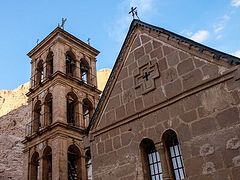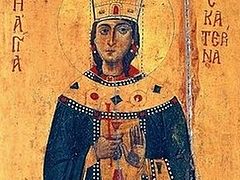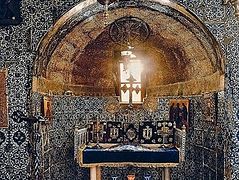Mt. Sinai, Egypt, February 25, 2020
The ancient St. Catherine’s Monastery at the foot of Mt. Sinai is home to one of the world’s most famous icon collections, and its icon of Christ Pantocrator is perhaps the single most recognizable Orthodox icon in the world.
Now that icon of Christ, along with more than 1,000 other sacred images, has been made available online by Princeton University, reports Aleteia.
Many of the treasures archived at the Icons of Sinai project of the Princeton University Department of Art and Archaeology pre-date the 8th and 9th-century periods of Iconoclasm when many ancient icons were destroyed.
The monastery’s website says of its icon collection:
Of all the Byzantine icons that survive in the world, over half of them are at Saint Catherine’s Monastery. This is due to the dry and stable climate, to the uninterrupted history of the monastery over the course of seventeen centuries, and to the vigilant care and devotion of the monks of Sinai. The most notable are panel icons from the 6th and 7th centuries executed in the encaustic technique, where wax is used as the medium for the pigments.
… The pre-iconoclastic icons at Sinai survived because Sinai was already at that time under the rule of the Moslems, and thus out of reach of the Iconoclast Emperors. Some scholars have speculated that icons were sent to Sinai for their safekeeping during this period.
There are numerous icons from the Comnenian dynasty. These are renowned for their hieratic quality, and distinctive polished gold haloes. The monastery preserves a number of vita icons, in which the principal figure of the saint, depicted in the centre of the panel, is surrounded by smaller icons depicting his life. These are some of the earliest vita icons in the world.
The monastery also possesses noteworthy examples of icons from the Palaeologan era, which are more painterly and more stylized, and significant examples of the Cretan school, where great attention was paid to details, and where the transition from light to dark in the modeling of flesh tones became more heightened. The monastery also possesses important examples of Russian icons from more recent centuries.
Many of these icons were brought to the monastery as gifts, but numerous icons were also executed at Sinai, and there is a distinctive Sinai school of iconography discernible in earlier centuries.
In the late 1950s, the monks of St. Catherine’s began to clean and restore their collection, and a team of professors from Princeton University, the University of Michigan, and the University of Alexandria began to make trips to the ancient monastery to photograph the icons.
The website currently presents 1,294 icons, with the addition of new images ongoing.





